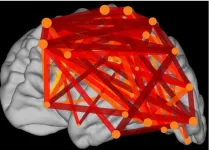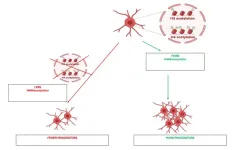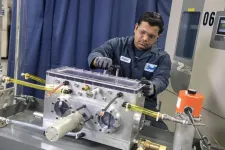(Press-News.org) Our brain interprets visual information by combining what we see with what we already know. A study published in the journal Neuron by researchers at the Champalimaud Foundation, and supported by the CaixaResearch Health Call of the la Caixa Foundation, reveals a mechanism for learning and storing this existing knowledge about the world. They found that neurons are wired to connect seemingly unrelated concepts. This wiring may be crucial for enhancing the brain’s ability to predict what we see based on past experiences, and bring us a step closer to understanding how this process goes awry in mental health disorders.
How do we learn to make sense of our environment? Over time, our brain builds a hierarchy of knowledge, with higher-order concepts linked to the lower-order features that comprise them. For instance, we learn that cabinets contain drawers and that Dalmatian dogs have black-and-white patches, and not vice versa. This interconnected framework shapes our expectations and perception of the world, allowing us to identify what we see based on context and experience.
“Take an elephant”, says Leopoldo Petreanu, senior author of the la Caixa-funded study. “Elephants are associated with lower-order attributes such as colour, size, and weight, as well as higher-order contexts like jungles or safaris. Connecting concepts helps us understand the world and interpret ambiguous stimuli. If you’re on a safari, you may be more likely to spot an elephant behind the bushes than you would otherwise. Similarly, knowing it’s an elephant makes you more likely to perceive it as grey even in the dim light of dusk. But where in the fabric of the brain is this prior knowledge stored, and how is it learned?”.
The brain’s visual system consists of a network of areas that work together, with lower areas handling simple details (e.g. small regions of space, colours, edges) and higher areas representing more complex concepts (e.g. larger regions of space, animals, faces). Cells in higher areas send “feedback” connections to lower areas, putting them in a position to learn and embed real-world relationships shaped by experience. For instance, cells encoding an “elephant” might send feedback to cells processing features like “grey”, “big” and “heavy”. The researchers therefore set about investigating how visual experience influences the organisation of these feedback projections, whose functional role remains largely unknown.
“We wanted to understand how these feedback projections store information about the world”, says Rodrigo Dias, one of the study’s first authors. “To do this, we examined the effects of visual experience on feedback projections to a lower visual area called V1 in mice. We raised two groups of mice differently: one in a normal environment with regular light exposure, and the other in darkness. We then observed how the feedback connections, and cells they target in V1, responded to different regions of the visual field”.
In mice raised in darkness, the feedback connections and V1 cells directly below them both represented the same areas of visual space. First author Radhika Rajan picks up the story, “It was amazing to see how well the spatial representations of higher and lower areas matched up in the dark-reared mice. This suggests that the brain has an inherent, genetic blueprint for organising these spatially aligned connections, independent of visual input”. However, in normally-reared mice, these connections were less precisely matched, and more feedback inputs conveyed information from surrounding areas of the visual field.
Rajan continues, “We found that with visual experience, feedback provides more contextual and novel information, enhancing the ability of V1 cells to sample information from a broader area of the visual scene”. This effect depended on the origin within the higher visual area: feedback projections from deeper layers were more likely to convey surround information compared to those from superficial layers.
Moreover, the team discovered that in normally-reared mice, deep-layer feedback inputs to V1 become organised according to the patterns they “prefer” to see, such as vertical or horizontal lines. “For instance”, Dias says, “inputs that prefer vertical lines avoid sending surround information to areas located along the vertical direction. In contrast, we found no such bias in connectivity in dark-reared mice”.
“This suggests that visual experience plays a crucial role in fine-tuning feedback connections and shaping the spatial information transmitted from higher to lower visual areas”, notes Petreanu. “We developed a computational model that shows how experience leads to a selection process, reducing connections between feedback and V1 cells whose representations overlap too much. This minimises redundancy, allowing V1 cells to integrate a more diverse range of feedback”.
Perhaps counterintuitively, the brain might encode learned knowledge by connecting cells that represent unrelated concepts, and that are less likely to be activated together based on real-world patterns. This could be an energy-efficient way to store information, so that when encountering a novel stimulus, like a pink elephant, the brain’s preconfigured wiring maximises activation, enhancing detection and updating predictions about the world.
Identifying this brain interface where prior knowledge combines with new sensory information could be valuable for developing interventions in cases where this integration process malfunctions. As Petreanu concludes, “Such imbalances are thought to occur in conditions like autism and schizophrenia. In autism, individuals may perceive everything as novel because prior information isn’t strong enough to influence perception. Conversely, in schizophrenia, prior information could be overly dominant, leading to perceptions that are internally generated rather than based on actual sensory input. Understanding how sensory information and prior knowledge are integrated can help address these imbalances”.
END
Pink elephants in the brain?
How experience shapes neural connectivity
2024-08-12
ELSE PRESS RELEASES FROM THIS DATE:
Heat caused over 47,000 deaths in Europe in 2023, the second highest burden of the last decade
2024-08-12
More than 47,000 people died in Europe as a result of high temperatures in 2023, the warmest year on record globally and the second warmest in Europe. This is the estimate of a study led by the Barcelona Institute for Global Health (ISGlobal), a centre supported by the "la Caixa" Foundation, and published in Nature Medicine. The researchers report that the vulnerability to heat of European societies has progressively decreased over the present century, and estimate that without these societal adaptation processes, the heat related mortality burden over the past year would have been 80% higher.
The study replicates the methodology used last year in another paper ...
Early-childhood tablet use and outbursts of anger
2024-08-12
About The Study: Child tablet use at age 3.5 years was associated with more expressions of anger and frustration by the age of 4.5 years in this study. Child proneness to anger/frustration at age 4.5 years was then associated with more use of tablets by age 5.5 years. These results suggest that early-childhood tablet use may contribute to a cycle that is deleterious for emotional regulation.
Corresponding Author: To contact the corresponding author, Caroline Fitzpatrick, PhD, email caroline.fitzpatrick@usherbrooke.ca.
To access the embargoed ...
Alcohol consumption patterns and mortality among older adults with health-related or socioeconomic risk factors
2024-08-12
About The Study: In this cohort study of older drinkers from the UK, even low-risk drinking was associated with higher mortality among older adults with health-related or socioeconomic risk factors. The attenuation of mortality observed for wine preference and drinking only during meals requires further investigation, as it may mostly reflect the effect of healthier lifestyles, slower alcohol absorption, or nonalcoholic components of beverages.
Corresponding Author: To contact the corresponding author, Rosario Ortolá, MD, PhD, ...
An appetizer can stimulate immune cells’ appetite, a boon for cancer treatments
2024-08-12
(Santa Barbara, Calif.) — The body has a veritable army constantly on guard to keep us safe from microscopic threats from infections to cancer. Chief among this force is the macrophage, a white blood cell that surveils tissues and consumes pathogens, debris, dead cells, and cancer. Macrophages have a delicate task. It’s crucial that they ignore healthy cells while on patrol, otherwise they could trigger an autoimmune response while performing their duties.
Researchers at UC Santa Barbara sought to understand how these immune cells choose what and when to eat. A paper published ...
New genetically engineered wood can store carbon and reduce emissions
2024-08-12
Researchers at the University of Maryland genetically modified poplar trees to produce high-performance, structural wood without the use of chemicals or energy intensive processing. Made from traditional wood, Engineered wood is often seen as a renewable replacement for traditional building materials like steel, cement, glass and plastic. It also has the potential to store carbon for a longer time than traditional wood because it can resist deterioration, making it useful in efforts to reduce carbon emissions.
But the hurdle to true sustainability in engineered wood is that it requires processing with volatile chemicals and a significant amount of energy, and ...
NK cells expressing interleukin-21 show promising antitumor activity in glioblastoma cells
2024-08-12
Natural killer (NK) cells engineered to express interleukin-21 (IL-21) demonstrated sustained antitumor activity against glioblastoma stem cell-like cells (GSCs) both in vitro and in vivo, according to new research from The University of Texas MD Anderson Cancer Center.
The preclinical findings, published today in Cancer Cell, represent the first evidence that engineering NK cells, a type of innate immune cell, to secrete IL-21 resulted in strong activity against glioblastoma, a cancer type in need of more effective treatment options.
“Our ...
Strong insurance laws help kids get access to mental health care
2024-08-12
When states require insurers to cover mental and behavioral health, children get better access to care, according to a UC San Francisco-led study of nearly 30,000 U.S. caregivers.
They found that 1 in 8 caregivers had difficulty accessing mental health services for their children between 2016 and 2019. But those who lived in states with the most comprehensive mental and behavioral health coverage laws were about 20% less likely to report trouble accessing care than those who lived in states with the least comprehensive laws.
Caregivers of Black and Asian children were more likely to report poor access to mental and ...
State-of-the-art brain recordings reveal how neurons resonate
2024-08-12
For decades, scientists have focused on how the brain processes information in a hierarchical manner, with different brain areas specialized for different tasks. However, how these areas communicate and integrate information to form a coherent whole has remained a mystery. Now, researchers at University of California San Diego School of Medicine have brought us closer to solving it by observing how neurons synchronize across the human brain while reading. The findings are published in Nature Human Behavior and are also the basis of a thesis by UC San Diego School of Medicine doctoral candidate Jacob Garrett.
“How the activity of the brain relates to the subjective ...
New study reveals unique histone tag in adult oligodendrocyte progenitor cells, opening doors for advanced myelin repair therapies
2024-08-12
NEW YORK, August 12, 2024 — In a groundbreaking study, researchers with the Advanced Science Research Center at the CUNY Graduate Center (CUNY ASRC) have identified a distinct histone tag in adult oligodendrocyte progenitor cells (OPCs) that may pave the way for innovative therapies targeting myelin repair, a critical target for several neurodegenerative and psychiatric disorders, including multiple sclerosis, Alzheimer’s disease, and schizophrenia. The histone tag, characterized by lysine 8 acetylation on histone H4, identifies a significant departure from the histone modifications found in neonatal OPCs.
Detailed in a ...
SwRI launches Electrified Vehicle and Energy Storage Evaluation-II battery consortium
2024-08-12
SAN ANTONIO — August 12, 2024 – Southwest Research Institute (SwRI) is launching the next phase of an electric vehicle (EV) battery consortium dedicated to understanding performance of energy storage systems. The Electrified Vehicle and Energy Storage Evaluation-II (EVESE-II) consortium builds on more than a decade of SwRI-led, precompetitive research with companies across the mobility sector.
“We are proud to serve the EV industry by bringing together manufacturers, suppliers and battery designers and developers with materials scientists to address a variety of challenges,” said Dr. Andre Swarts, an SwRI staff engineer ...
LAST 30 PRESS RELEASES:
Autistic and non-autistic faces may “speak a different language” when expressing emotion
No clear evidence that cannabis-based medicines relieve chronic nerve pain
Pioneering second-order nonlinear vibrational nanoscopy for interfacial molecular systems beyond the diffraction limit
Bottleneck in hydrogen distribution jeopardises billions in clean energy
Lung cancer death rates among women in Europe are finally levelling off
Scientists trace microplastics in fertilizer from fields to the beach
The Lancet Obstetrics, Gynecology, & Women’s Health: Taking paracetamol during pregnancy does not increase risk of autism, ADHD or intellectual disabilities, confirms new gold-standard evidence review
Taking paracetamol during pregnancy does not increase risk of autism, ADHD or intellectual disabilities
Harm reduction vending machines in New York State expand access to overdose treatment and drug test strips, UB studies confirm
University of Phoenix releases white paper on Credit for Prior Learning as a catalyst for internal mobility and retention
Canada losing track of salmon health as climate and industrial threats mount
Molecular sieve-confined Pt-FeOx catalysts achieve highly efficient reversible hydrogen cycle of methylcyclohexane-toluene
Investment in farm productivity tools key to reducing greenhouse gas
New review highlights electrochemical pathways to recover uranium from wastewater and seawater
Hidden pollutants in shale gas development raise environmental concerns, new review finds
Discarded cigarette butts transformed into high performance energy storage materials
Researchers highlight role of alternative RNA splicing in schizophrenia
NTU Singapore scientists find new way to disarm antibiotic-resistant bacteria and restore healing in chronic wounds
Research suggests nationwide racial bias in media reporting on gun violence
Revealing the cell’s nanocourier at work
Health impacts of nursing home staffing
Public views about opioid overdose and people with opioid use disorder
Age-related changes in sperm DNA may play a role in autism risk
Ambitious model fails to explain near-death experiences, experts say
Multifaceted effects of inward foreign direct investment on new venture creation
Exploring mutations that spontaneously switch on a key brain cell receptor
Two-step genome editing enables the creation of full-length humanized mouse models
Pusan National University researchers develop light-activated tissue adhesive patch for rapid, watertight neurosurgical sealing
Study finds so-called super agers tend to have at least two key genetic advantages
Brain stimulation device cleared for ADHD in the US is overall safe but ineffective
[Press-News.org] Pink elephants in the brain?How experience shapes neural connectivity



